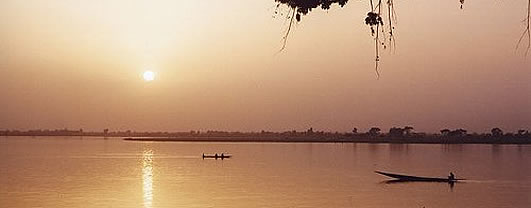Mali

With a past infinitely more glorious than itÂs present, Mali was the seat of the first emergent African trading empires to straddle the trans-Saharan trade routes, from which the region achieved enormous wealth and influence over the course of many centuries.
The first of these was the Ghana Empire, geographically distinct from the current nation of Ghana, which thrived between the 8th century and the turn of the first millennium. The region then gradually fell under the control of the Berber dominated Almoravids who introduced the first substantial influence of Islam. The region is dominated and defined by the Niger River, the principal West African waterway, around which the Mali Empire later formed. This was followed by the Songhai Empire that governed the region until the growing European influence on the coast, and the bourgeoning tran-Atlantic slave trade, began to supplant and undermine these powerful tradition systems of rule.
The net result of all this is a nation that bridges the Arabic north and the Bantu south, with a deeply layered fusion of both, and overlaid somewhat by the influence of a relatively brief but assertive period of occupation by the French. Although now one of the poorest countries in Africa, it is also an excellent travel destination with a striking diversity of landscapes and cultures, and a lively if somewhat conservative African ambience surrounded by monuments to a diverse and ancient history.
Travel To & Within Mali
Flights To Mali Accommodation In Mali
Why Travel To Mali
Mali is a ostensibly a French speaking country, and with its long ties to France, is a popular destination for French travellers. It used to be the principal overland route from Europe to West and Central Africa, and to a degree still is, but border insecurity in the north, combined with increasing militancy of the nomad groups of the Sahara, has curtailed much of this traffic.
However there is still much to see in Mali, and although you will be disappointed if you arrive in the country expecting an African experience in the traditional sense of the word, since Mali has almost nothing in the way of preserved wildlife, but is essentially a cultural destination that, if this is your field of interest, could absorb and fascinate you for a lifetime.
In terms of ancient culture Mali has four UNESCO World Heritage Sites, the famous perhaps being the historic city of Djenné, home to the Great Mosque of Djenné, the principal example of local mud brick and adobe architecture which is perhaps the defining image of Mali. This style is replicated all over the country, and has been the subject of a great deal of photographic and archaeological study.
Other sites include Bandiagara Escarpment, a series of sandstone cliffs with cave dwellings and ancient rupestrian villages not unlike the New Mexican Pueblos, the city of Timbuktu along the Niger River, and the Tomb of Askia in the city of Gao, also along the Niger River.
A surprising fact is the global popularity and prolificacy of Malian music, with the most famous practitioners being Ali Farka Touré and Salif Keita. The best of Malian musicians live abroad, and mainly in France, but the local scene is diverse and accessible, and definitely something to look for when you arrive in the country.
Besides all this, just the landscape itself, with the influences of desert in the north and the Sahel in the south, and dissected by one of the worldÂs great waterways, is so diverse, and at times so outlandish, that it rewards just the simple process of travel with no greater end in mind.
When To Visit Mali
If you are a world music junkie, or just a music fan in general, one of the great lesser known music festivals in the Malian Festival in the Desert which takes place near the city of Timbuktu, usually in early January.
January is at the outer limit of the comfortable time to visit Mali, however, after which the summer heat becomes oppressive. The best time to visit is between November and January, before the searing summer and after the rains which run from June to September. There is no time that can be regarded as cool, and the annual Harmattan dust storms can make the period from January to June uncomfortable. These winds blow in off the Sahara and can plunge the entire region into fog of fine, suspended dust.
The busy tourist season is mainly in November.
Travel Warning
North of Timbuktu, and anywhere along the lonely road leading north to Algeria, there is the risk of kidnapping and armed banditry. The degree of risk is difficult to determine, but the area is sparsely policed, with banditry, armed extremism and smuggling prevalent along the Niger and Algerian borders.
Elsewhere in the country crime is limited but sensible precautions are advisable.
Malaria is not a particular problem in Mali, but other tropical diseases are common. The incidence of AIDS/HIV infection in the country is low, although it makes sense to avoid any high risk sexual behaviour, which in a conservative country like Mali could be any overt sexual behaviour, although, surprisingly, homosexuality is legal.